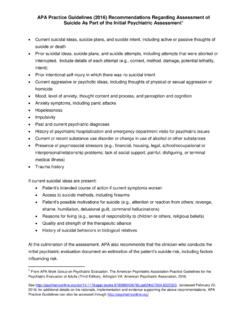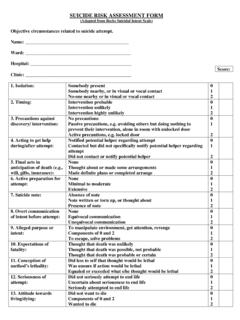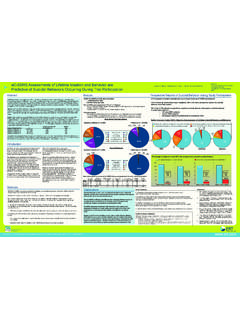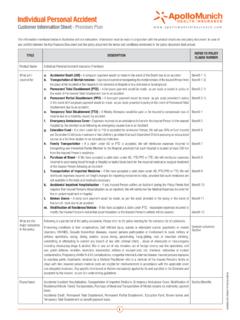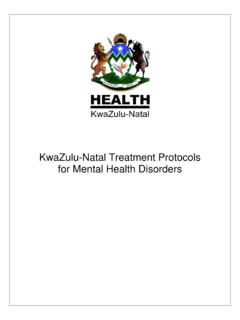Transcription of The Joint Commission - Stop a Suicide
1 One Washington Street Suite 304 Wellesley Hills, MA 02481 p f A Resource Guide for Implementing The Joint Commission 2007 Patient Safety Goals on Suicide Featuring the Suicide Assessment Five-step Evaluation and Triage (SAFE-T) Prepared by Douglas Jacobs, MD CEO and President, Screening for Mental Health, Inc. Dr. Jacobs would like to acknowledge the American Psychiatric Association (APA) for permission to use content from the APA Practice Guideline for the Assessment and Treatment of Patients with Suicidal Behaviors, and Laura Fochtmann, MD for her thoughtful editorial assistance.
2 2007 by Screening for Mental Health, Inc. This resource guide may be copied and distributed by healthcare professionals and organizations. SMH Resource Guide Page 2 TABLE OF CONTENTS Statement of 3 The Joint Commission s Goal Requirement on 4 The Suicide Assessment Five-step Evaluation and Triage (SAFE-T) .. 5 Applying the SAFE-T Model to the Joint Commission s Goal .. 6 M(C)1: The risk assessment includes identification of specific factors and features that may increase or decrease risk for 6 Step 1: SAFE-T, Risk Factors Step 2: SAFE-T, Protective Factors Step 3: SAFE-T, Specific Suicide Inquiry M(C)2: The client s immediate safety needs and most appropriate setting for treatment are 9 Step 4.
3 SAFE-T, Level of Risk/Intervention Immediate Patient Safety Needs in the Emergency Department Treatment Setting Selection Inpatient Suicide Assessments Immediate Safety Needs of Hospitalized Patients Suicide Risk and Observation Levels Safety Needs to Consider in the Physical Environment M(C)3: The organization provides information such as a crisis hotline to individuals and their family members for crisis 15 Step 5: SAFE-T, Documentation Suicide Risk Following Discharge Patient Discharge Guidelines Other Documentation Guidelines Screening for Mental Health and Douglas Jacobs, 17 Glossary of 18 19 SMH Resource Guide Page 3 STATEMENT OF intent The Joint Commission has recently published its 2007 National Patient Safety Goals1, including a requirement related to patient Suicide .
4 Screening for Mental Health, Inc. in collaboration with The Suicide Prevention Resource Center (SPRC), developed a Suicide assessment protocol, the Suicide Assessment Five-step Evaluation and Triage (SAFE-T) 2. This document serves as a resource guide, using the SAFE-T protocol as a centerpiece to facilitate implementation of the Joint Commission patient safety goal on Suicide . This material is not intended to function as a standard of care, nor does it include every acceptable approach to meeting this goal. The following resources were used: American Psychiatric Association Practice Guidelines for the Assessment and Treatment of Patients with Suicidal Behaviors3/4 The SAFE-T, a Suicide assessment protocol for mental health care providers developed by Douglas Jacobs, MD and The Suicide Prevention Resource Center5 The Suicide risk assessment teleconference training sponsored by the National Association of Psychiatric Health Systems (NAPHS)
5 6 For specific questions about the Joint Commission s requirement and/or applicability contact The Joint Commission at 630-792-5000 or visit the website For more information on ordering laminated copies of the SAFE-T, please visit SMH Resource Guide Page 4 THE Joint Commission GOAL 15A: THE ORGANIZATION IDENTIFIES CLIENTS AT RISK FOR Suicide According to The Joint Commission , the requirements apply only to behavioral healthcare and psychiatric hospitals and patients being treated for emotional or behavioral disorders in general hospitals. Rationale for Requirement 15A Suicide ranks as the eleventh most frequent cause of death (third most frequent in young people) in the United States, with one person dying from Suicide every minutes.
6 Suicide of a care recipient while in a staffed, round-the-clock care setting has been the #1 most frequently reported type of sentinel event since the inception of the Joint Commission s Sentinel Event Policy in 1996. Identification of individuals at risk for Suicide , while under the care of, or following discharge from a health care organization, is an important first step in protecting and planning the care of these at-risk individuals7. Implementation Expectations for Requirement 15A (M) C risk assessment includes identification of specific factors and features that may increase or decrease risk for Suicide .
7 (M) C 2. The client s immediate safety needs and most appropriate setting for treatment are addressed. (M) C 3. The organization provides information such as a crisis hotline to individuals and their family members for crisis situations. SMH Resource Guide Page 5 THE Suicide ASSESSMENT FIVE-STEP EVALUATION AND TRIAGE (SAFE-T) At the core of Screening for Mental Health s (SMH) mission is the dissemination of educational materials and resources to healthcare professionals. In collaboration with the Suicide Prevention Resource Center, SMH designed the SAFE-T, a Suicide assessment protocol consistent with the American Psychiatric Association Practice Guidelines for the Assessment and Treatment of Patients with Suicidal Behaviors.
8 This protocol outlines a series of steps in conducting a comprehensive Suicide assessment, estimating Suicide risk and developing treatment plans and interventions responsive to the risk level; however, the ultimate determination of Suicide risk is a clinical judgment. SAFE-T ( Suicide Assessment Five-step Evaluation and Triage) 1. Identify risk factors, noting those that can be modified to reduce risk 2. Identify protective factors, noting those that can be enhanced 3. Conduct Suicide inquiry: suicidal thoughts, plans, behavior and intent 4. Determine level of risk and choose appropriate intervention to address and reduce risk 5.
9 Document the assessment of risk, rationale, intervention and follow-up instructions The question regarding the utility of Suicide scales in clinical practice is often raised and was thoroughly addressed in the APA Practice Guidelines for the Assessment and Treatment of Patients with Suicidal Behaviors. Below, please find an excerpt from page 23 on this point. Understand the Relevance and Limitations of Suicide Assessment Scales8 Although a number of Suicide assessment scales have been developed for use in research .., their clinical utility is limited. Self-report rating scales may sometimes assist in opening communication with the patient about particular feelings or experiences.
10 In addition, the content of Suicide rating scales, such as the Scale for Suicide Ideation and the Suicide intent Scale, may be helpful to psychiatrists in developing a thorough line of questioning about Suicide and suicidal behaviors. However, existing Suicide assessment scales suffer from high false positive and false negative rates and have very low positive predictive values. As a result, such rating scales cannot substitute for thoughtful and clinically appropriate evaluation and are not recommended for clinical estimations of Suicide risk. SMH Resource Guide Page 6 APPLYING THE SAFE-T MODEL TO THE Joint Commission GOAL In preparing this resource guide, the SAFE-T protocol has been amplified to demonstrate a method for implementing the new Joint Commission requirements on patient safety.
